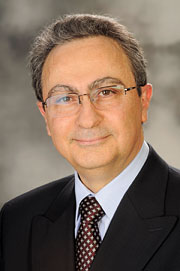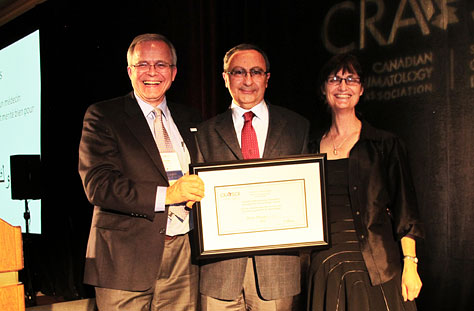Summer 2014 (Volume 24, Number 2)
The CRA’s 2014 Distinguished Rheumatologist:
Dr. Boulos Haraoui
Download PDF

1. Why did you become a rheumatologist? What or who influenced you along the way to do so?
During medical school and my internal medicine training, I was always fascinated by complex multisystem cases which did not rely solely on laboratory or imaging techniques for diagnosis, but required detailed medical history taking and a thorough physical exam. This narrowed my choices to endocrinology and rheumatology; rheumatology won after I met
Dr. Guy Germain (who was the head of the department at the time at the Université de Montréal) during my rotation. He was passionate and dedicated to his patients, and showed me the great satisfaction I could glean from a career in rheumatology; ultimately, he suggested that I should focus on rheumatoid arthritis (RA), the big crippling disease, by pursuing a fellowship. This is how I ended up doing basic and clinical research at the National Institutes of Health (NIH) with the help of a scholarship from The Arthritis Society (TAS).
2. What do you believe are the qualities of a distinguished rheumatologist? How do you feel you embody these qualities?
A rheumatologist is by definition a compassionate physician who understands patient suffering and strives to alleviate it; at the same time, though, understanding that rheumatologic conditions have complex underlying pathophysiology. My training allowed me to better appreciate the huge unmet need in term
of therapies and at the same time the big potential of immune modulation. This convinced me to focus my practice on RA and led to my involvement in multicentre collaborations through clinical trials, the Canadian Rheumatology Research Consortium (CRRC) network, the Canadian Early Arthritis (CATCH) cohort, and other initiatives aimed at improving patient care such as the Treat to Target (T2T) program.
Focused teamwork is the key to success; you need to be a team player but, at the same time, exercise leadership by bringing and developing new ideas.
3. In recent years the Canadian Initiative for Outcomes in Rheumatology Care (CIORA) has become one of the largest arthritis research-funding agencies in Canada. What was the effect of integrating with the CRA? How else do you foresee the landscape of rheumatology clinical research changing over the next decade?
One of the achievements I am most proud of is the growth of CIORA, which started as a one-company initiative and is now funded by several others. CIORA is currently the third-largest rheumatology research-funding agency in Canada. It is important for the CRA to have a say and a contribution in rheumatology research. By focusing on clinical research, CIORA complements several educational and practice management initiatives of the CRA. This allows the CRA to set priorities for research in areas of unmet needs in patient care and also to support the work of young clinical investigators.
4. Your tenure within the CRA is long and storied. What do you feel is your lasting legacy within the organization?
Two legacies stand out: The first is the “French Power” contribution to the advancement of the CRA following in the footsteps of several predecessors. I hope it helps open the door to a younger generation of rheumatologists from Quebec. Another would be bringing CIORA to the CRA after it had matured as an independent organization; it fills an important mission for the advancement of patient care in Canada.
5. Your work in biologics trials in RA has shaped the landscape for research and inquiry. Why are biologics of such tremendous importance in the treatment armamentarium? What developments do you anticipate as future success and challenges?
Biologics have tremendously improved the lives of thousands of patients in Canada. Rheumatologists are now able to “promise” better tomorrows to their patients. That said, after 15 years and several available biologics, we are at a stage where we need to better strategize our treatment approaches by early detection and treatment, developing tools to identify subsets of patients and aiming to individualize therapies.
Moreover, RA is not just a “joints” disease and requires management of all the co-morbidities and extra-articular features. This will require multi-
disciplinary teams with nurses, allied health professionals, and pharmacists, along with collaboration with other medical specialties such as pulmonary medicine and cardiology. We need to convince our health authorities to invest in such initiatives.

Dr. Haraoui receiving his award from CRA President Dr. Carter Thorne and Dr. Janet Pope.
6. You are trilingual and participate in rheumatology societies across the globe. What advances are being made in international forums that are shaping Canadian initiatives? How have your international sojourns shaped your perspectives on the Canadian field?
My international interactions have allowed me to see the high esteem in which Canadian rheumatology is held, and how we influence practice in several countries. At the same time these interactions have allowed me to appreciate the importance of collaborative work at which certain countries excel. This has convinced me that we need to have such models in Canada through national initiatives (e.g., CRRC, CATCH) and, at the same time, bring Canadian expertise and contributions to international programs such as the T2T and the Evidence, Expertise, Exchange Initiative (3E).
7. What has been the most poignant observation you have realized over the course of your career?
My saddest observation is the decline of industry-sponsored clinical trials in Canada. I have witnessed the exciting times of the first biologics trials in the late 1990s and early 2000s where I could see the “miraculous” improvement of patients within weeks. Over the years, clinical trial designs did not keep pace with the changes of optimal management of RA, and it became increasingly difficult to include patients and be able to gain experience with new therapies before they become available in Canada. Moreover, the transition from in-house management of trials by pharmaceutical companies to Contract Research Organizations (CROs) has severed the ties investigators had with the medical personnel and departments within the companies. These ties are crucial in order to influence trial designs and foster other collaborations. Add to that the complexities of new legal requirements and it is almost impossible for an individual clinician to build and sustain a clinical-trial set up.
8. You are marooned on a desert island. What is the one book you want with you?
The Prophet by Khalil Gibran. It summarizes in a few pages all of the experience of humanity. I have read it at least a dozen times and always find something new to reflect upon.
9. What do you love most about living in Montreal?
For somebody coming from the Middle East with a French educational background, Montreal offers the best mix of North American culture “modulated” by European influence. It is the only city where you can seamlessly alternate in the same conversation between English and French (and sometimes a third language, Arabic in my case). Montreal has also a vibrant cultural life and great, great restaurants. Outdoor activities are easily within reach, too.
Boulos Haraoui, MD, FRCPC
Associate Professor of Medicine,
Université de Montréal
Head,
Clinical Research Unit in Rheumatology,
Centre hospitalier de l'Université de Montréal (CHUM)
Chair,
CIORA Steering Committee
Montreal, Quebec
|



